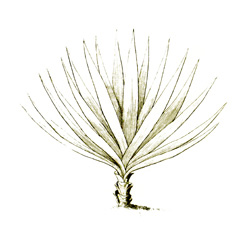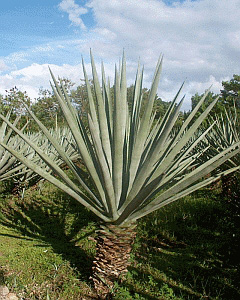 |
|
https://edibleplants.org/ |
 |
| wikimedia.org |
Translate this page:
Summary
Sisal or Agave sisalana belongs in the Asparagaceae family and is native to southern Mexico but largely cultivated in many other countries of the tropics, subtropics, and warm temperate areas for its high quality fibre. The sisal fibre is used for rope, twine, paper, cloth, bags, dartboards, footwear, and carpets. It is an evergreen, succulent plant with a large rosette of leaves 60 ? 160 cm long that eventually forms to a flowering stem of up to 6 m in height. Few minute teeth are visible along the margins of young leaves but vanish as leaves mature. The plant typically produces about 250 commercially usable leaves throughout its 7-10 years life-span, with each leaf containing an average of around 1000 fibres. The sharp leaf spines are used traditionally in Central America as needles. The heart of new shoots are cooked and eaten as vegetables. The sweet sap is fermented to make beer and the roots, as well, are used in the production of alcoholic beverage. Further, sisal plant is a folk remedy for dysentery, leprosy sores, and syphilis. Other Names: Mkonge, Shikwenga, Te robu, Umugweegwe, Yaxci.
Physical Characteristics

 Agave_sisalana is an evergreen Perennial growing to 2 m (6ft) by 2 m (6ft) at a fast rate.
Agave_sisalana is an evergreen Perennial growing to 2 m (6ft) by 2 m (6ft) at a fast rate.
See above for USDA hardiness. It is hardy to UK zone 10 and is frost tender. The plant is self-fertile.
Suitable for: light (sandy), medium (loamy) and heavy (clay) soils, prefers well-drained soil and can grow in nutritionally poor soil. Suitable pH: mildly acid, neutral and basic (mildly alkaline) soils. It can grow in semi-shade (light woodland) or no shade. It prefers dry or moist soil and can tolerate drought.
UK Hardiness Map
US Hardiness Map
Synonyms
Agave amaniensis Trel. & Nowell Agave rigida sisalana (Perrine) Engelm. Agave segurae D.Guillot & P.
Plant Habitats
Edible Uses
Edible portion: Leaves, Sap, Plant heart, Vegetable. Root. The heart of new shoots - cooked[ 301 ]. The sap from the flower stalk is fermented to make an alcoholic drink[ 301 ]. The roots are used in the production of an alcoholic beverage[ 301 ].
References More on Edible Uses
Medicinal Uses
Plants For A Future can not take any responsibility for any adverse effects from the use of plants. Always seek advice from a professional before using a plant medicinally.
Sisal is a folk remedy for dysentery, leprosy sores, and syphilis. It is a source of hecogenin[ 317 ]. The leaves contain hecogenin used in the partial synthesis of the drug cortisone[ 418 ].
References More on Medicinal Uses
The Bookshop: Edible Plant Books
Our Latest books on Perennial Plants For Food Forests and Permaculture Gardens in paperback or digital formats.

Edible Tropical Plants
Food Forest Plants for Hotter Conditions: 250+ Plants For Tropical Food Forests & Permaculture Gardens.
More

Edible Temperate Plants
Plants for Your Food Forest: 500 Plants for Temperate Food Forests & Permaculture Gardens.
More

More Books
PFAF have eight books available in paperback and digital formats. Browse the shop for more information.
Shop Now
Other Uses
Other uses rating: High (4/5). Agroforestry Uses: The plant is cultivated for fences as well as for protection against soil erosion[ 317 ]. Short fibres from the leaves, obtained as by-products, are used for production of compost[ 317 ]. Other Uses A high quality fibre is obtained from the leaves[ 317 ].The leaves provide one of the most important hard fibres, it is used for making ropes and all kinds of strings, fishing-nets, hammocks, door-curtains, floor-covers, bags etc[ 317 ]. The fibre cannot be spun as finely as jute and ropes tend to break suddenly[ 418 ]. Short fibres, obtained as by-products, are used for production of cellulose, paper as well as for upholstery material[ 317 ]. Fibres are also used to reinforce plaster boards and paper[ 418 ]. The waste material, after extraction of the fibre, is reported to be molluscicidal and fungistatic and can be used as mulch for plants[ 317 ]. The sharp leaf spines are traditionally used as needles[ 317 ]. Nectary - Flowers rich in nectar and pollen: Yes – Agave flowers produce nectar that attracts various pollinators, including bees and butterflies, especially when in bloom. 2. Wildlife - Food (Fruit, Seeds, Leaf litter, Shelter, Nesting, Roosting): No – While the plant itself is not typically consumed directly by wildlife as food, the nectar can attract pollinators. The leaves can provide some cover, but they do not serve as a primary source of food, shelter, or nesting material for wildlife. 3. Invertebrate Shelter (Overwintering sites, Leaf litter, ground cover): No – Agave does not provide significant shelter for invertebrates or contribute to ground cover in the same way as other plants might. 4. Pest Confuser (Smell): No – The scent of the agave plant is not specifically noted for confusing pests, although the flowers may attract beneficial insects.
Special Uses
References More on Other Uses
Cultivation details
A plant of the drier tropics and subtropics, where it is found at elevations up to 2,000 metres. It grows best in areas where annual daytime temperatures are within the range 15 - 27c, but can tolerate 10 - 45c[ 418 ]. It can be killed by temperatures of -5c or lower[ 418 ]. It prefers a mean annual rainfall in the range 900 - 1,250mm, but tolerates 500 - 1,800mm[ 418 ]. Requires a sunny position in a well-drained soil. Prefers a pH in the range 6 - 7.5, tolerating 5.5 - 8[ 418 ]. The plant has escaped from cultivation in many of the areas in which it is cultivated and has become invasive in some areas including several of the Pacific Islands and Australia[ 305 ]. Harvesting the leaves for fibre can begin 2 - 4 years after planting, depending on temperature, and usually continues for about 10, occasionally up to 20, years before the plant flowers and dies[ 418 ]. The average yield is about 0.9 tonnes/ha of dried fibres[ 418 ]. On the best plantations in East Africa, yearly yields of 2.0 - 2.5 tonnes/ha of dried fibres are obtained[ 418 ]. A monocarpic species - the plant lives for several years without flowering but dies once it does flower. However, it normally produces plenty of suckers during its life and these continue growing, taking about 10 - 15 years in a warm climate, considerably longer in colder ones, before flowering[ 11 ]. The roots rarely go deeper than about 35cm[ 418 ]. One ton of fibre removes about 30 kg N, 5 kg P, 80 kg K, 65 kg Ca and 40 kg Mg from the field. Because the fibres contain few minerals, most of the nutrients can be returned to the land with the pulp[ 418 ]. The main harvest of the agave hearts (piñas) occurs after about 7 to 10 years, typically in late winter to early spring, depending on the climate and growing conditions.
Agave usually flowers once it reaches maturity, which can be after 7 to 10 years. The flowering period generally occurs from late spring to summer.
References Carbon Farming Information and Carbon Sequestration Information
Temperature Converter
Type a value in the Celsius field to convert the value to Fahrenheit:
Fahrenheit:
The PFAF Bookshop
Plants For A Future have a number of books available in paperback and digital form. Book titles include Edible Plants, Edible Perennials, Edible Trees,Edible Shrubs, Woodland Gardening, and Temperate Food Forest Plants. Our new book is Food Forest Plants For Hotter Conditions (Tropical and Sub-Tropical).
Shop Now
Plant Propagation
Propagation method by dividing rhizomes, tubers, corms or bulbs (including offsets) From bulbils. Seed Collecting: Allow pods to dry on plant; break open to collect seeds. Plants are normally grown from suckers or from the bulbils on the flower stalk. Mostly very few of the seeds will grow. After flowering the whole plant dies. Flowering normally occurs after 7 years.
Other Names
If available other names are mentioned here
Mkonge, Shikwenga, Te robu, Umugweegwe, Yaxci.
Native Range
NORTHERN AMERICA: Mexico (Campeche) SOUTHERN AMERICA: West Indies PACIFIC: United States (Hawaii, United States Minor Outlying Islands), Palau, French Polynesia (Society Islands), Fiji, Nauru AUSTRALASIA: Australia (Queensland) EUROPE: Spain
Weed Potential
Right plant wrong place. We are currently updating this section.
Please note that a plant may be invasive in one area but may not in your area so it's worth checking.
This plant can be weedy or invasive in Florida. [1c] Invasive in Cuba, Hawaii, Puerto Rico, the Pacific Islands, and Spain. Weedy in Queensland's east coast. [1d]
Conservation Status
IUCN Red List of Threatened Plants Status : This taxon has not yet been assessed.

Growth: S = slow M = medium F = fast. Soil: L = light (sandy) M = medium H = heavy (clay). pH: A = acid N = neutral B = basic (alkaline). Shade: F = full shade S = semi-shade N = no shade. Moisture: D = dry M = Moist We = wet Wa = water.
Now available:
Food Forest Plants for Mediterranean Conditions
350+ Perennial Plants For Mediterranean and Drier Food Forests and Permaculture Gardens.
[Paperback and eBook]
This is the third in Plants For A Future's series of plant guides for food forests tailored to
specific climate zones. Following volumes on temperate and tropical ecosystems, this book focuses
on species suited to Mediterranean conditions—regions with hot, dry summers and cool, wet winters,
often facing the added challenge of climate change.
Read More
Expert comment
Author
Perrine
Botanical References
1
Links / References
For a list of references used on this page please go here
A special thanks to Ken Fern for some of the information used on this page.
Readers comment
| Add a comment |
|
If you have important information about this plant that may help other users please add a comment or link below. Only comments or links that are felt to be directly relevant to a plant will be included. If you think a comment/link or information contained on this page is inaccurate or misleading we would welcome your feedback at [email protected]. If you have questions about a plant please use the Forum on this website as we do not have the resources to answer questions ourselves.
* Please note: the comments by website users are not necessarily those held by PFAF and may give misleading or inaccurate information.
To leave a comment please Register or login here All comments need to be approved so will not appear immediately.
|
|